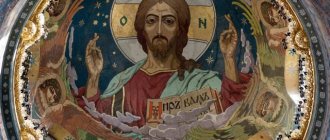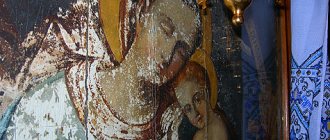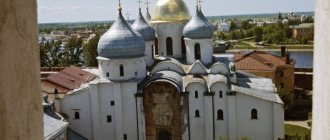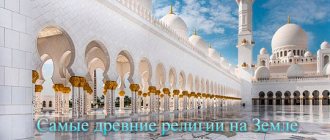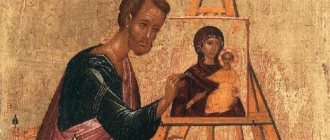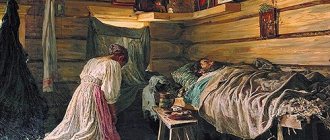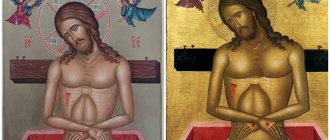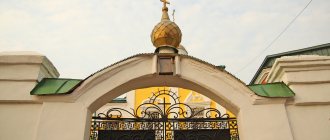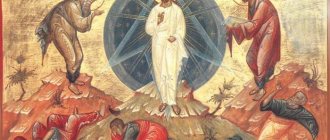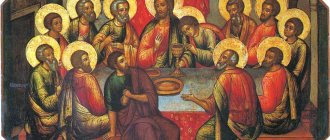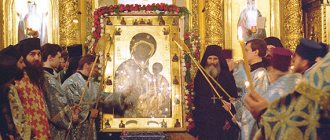What is unique about the oldest icon in the world?
A distinctive feature of icon painting as an artistic art is that the faces of saints, as a rule, were depicted symmetrical. In the icon of Christ Pantocrator from the Monastery of St. Catherine, this rule is not observed. Moreover, researchers are confident that the ancient icon painter did this completely intentionally.
Most scientists believe that in this way the artist seems to emphasize the dual natural nature of Christ, demonstrating both divine and human traits in him. The divine essence of Jesus is represented by his right side, which shows his hand raised in a gesture of blessing. The left side of the image, in which Christ holds the Holy Gospel, symbolizes the human nature of the Savior.
Theologians suggest that icons painted in this style were very rare. In addition, it is believed that it was the “asymmetrical faces” that were more often than other icons subjected to desecration and destruction during the era of iconoclasm.
Kazan Icon of the Mother of God | Author unknown
Russian princes wanted to establish dominance over Kazan since the 1160s. The military campaign of John IV ended in success in 1552.
But relations between the residents of this city and the Russian people were strained, since their religions were different. The Emperor began to think about how to unite people. In 1579 there was a fire in the city and it burned completely.
At the same time, the Mother of God came to a nine-year-old girl in a dream and ordered her to find her icon on the ashes. No one believed the child, so the girl found the sacred image on her own. It was decided to move the found relic to the first Kazan Orthodox church.
Interesting fact : when the image was transferred to the temple, two blind men received their sight. This miracle became a harbinger of the spread of Christianity in the lands previously belonging to the Tatars.
The Kazan Icon of the Mother of God is famous for the fact that thanks to prayers before it, many miracles happened, people were healed, and the country avoided wars. Until 1904 it was in Russia, but then disappeared.
How was the oldest icon in the world preserved?
The Christian monastery of St. Catherine in the Egyptian rock desert of Sinai was built in the period from 548 to 565 AD at the behest of the Byzantine emperor Justinian I. The area in which the shrine is located is located secluded and at a sufficient distance from all trade roads and routes running in these lands.
The remote location of the monastery allowed it to preserve its relics from conquerors, bandits and robbers, who at all times carried on their “fishery” on the trade routes in Sinai. The holy monastery, even now, is considered remote and difficult to access for pilgrims and travelers. However, every year many believers visit St. Catherine's Monastery.
Behind the walls of this monastery are collected unique relics of early Christianity. In addition to the world's oldest icon of Christ Pantocrator, the monastery houses more than 2 thousand other ancient images of saints and church artifacts created from the 6th century to the present day.
Source
Saint Nicholas (Ugresh Icon) | Author unknown
Nicholas the Wonderworker was one of the most revered saints in Rus'; mentions of him are found in chronicle sources dating back to the 11th century.
The history of the creation of the St. Nicholas Ugresh Monastery and the Ugresh Icon of St. Nicholas dates back to the 1380s.
During this period, Prince Dmitry Ioannovich Donskoy went on a campaign against Mamaia. When he and his comrades left Moscow, he saw the image of the Wonderworker, decorated with a vape, surrounded by stars and radiance. Dmitry Donskoy, who saw this phenomenon, perked up, as he considered the sign to be good.
In honor of this event, the St. Nicholas Ugreshsky Monastery was erected. His priceless relic was the miraculous icon of St. Nicholas (Ugresh Icon) . It is an example of ancient Russian iconography.
Criteria for evaluating antique images
An antique is an old thing that has a high market value. An entire team of specialists with extensive experience in this field often works to evaluate antique icons. If a person is the owner of an ancient icon painting, he simply needs to know the market value of this item. Otherwise, when selling the icon, the owner will receive a relatively smaller amount. How to determine the age of an icon? This question interests many collectors. After all, this aspect plays a decisive role in determining the cost.
Market value depends on several important factors:
- time of writing, that is, age;
- author of the image;
- the presence or absence of a salary and precious stones;
- size;
- presence of marks on the back of the product;
- external condition;
- Is the product subject to restoration?
Settings were often used to decorate ancient icons. More valuable are the icons in a gold frame. Less often you can find images with precious stones. Icons in a silver frame also have a fairly high cost. There are cases when a precious frame is worth more than the iconographic image itself.
In addition to all the criteria described above, the cost is influenced by the plot of the image and miraculous properties.
Authenticity of the iconographic image
Before assessing the value of an icon, it is necessary to determine its authenticity. Any specialist can recognize an ordinary fake. But to determine a high-quality copy, an examination will be required. People have long learned to paint antique images using certain techniques. The most difficult thing is to determine the authenticity when an ancient icon is completed by the hand of a younger master. In this case, the examination is carried out in a laboratory using special equipment. They study the base of the icon, the soil, and possible interventions.
Don Icon of the Mother of God | Author: Feofan the Greek
This image was painted in the 14th century by Theophanes the Greek. He gained wide fame thanks to the miracles he performed. Prayer before him helped Russian soldiers in battles with the Golden Horde.
Also, the icon of the Don Mother of God contributed to the victory of Russian soldiers in the Battle of Kulikovo. Prince Dmitry Donskoy, who led this battle, renamed the Assumption Cathedral, located in Kolomna in Donskoy, and the icon of the Most Holy Theotokos that was in it also began to be called Donskoy.
The image has brought victories to Russian soldiers more than once; for example, thanks to it they won a victory against the Kazan khans, and also made a successful campaign against Polotsk.
Interesting fact : one of the main miracles performed thanks to prayers to this icon is considered to be the salvation of the capital of Russia from the attacks of the Crimean Tatars.
General information about icons, their spiritual value
The face depicted on the icon is not the Lord God. It is believed that it is intended only to remind the praying person of the Divine. That’s why they write on the icon not the face, but the face. Very important in him are the eyes, which reflect the depth of the soul. No less significant are the hands, whose gestures carry a certain meaning.
The rest of the figure is very airy, as it is designed to show inner strength. This is exactly what the emphasis is on.
At a certain period of time, a religious theme became popular among artists. And it seems that there is a painting and an icon on the same topic; the same saint is depicted on it, for example. But on the first canvas there is spirituality, but on the second there is none. Therefore, when painting icons, they demand that canons that were written long ago be observed, which exclude random details. Each fragment carries a certain semantic and spiritual meaning.
Ancient icon
Some of the rarest and most valuable monuments of Russian icon painting are the icons of Ancient Rus'. Monuments of icon painting of the Pre-Mongol period are counted in only a few and are located in state museums. These are truly rare ancient icons. This article will focus on a more numerous segment - icons of the 14th-17th centuries. The artistic merits of an ancient icon are indicated by the peculiarities of the background, the proportions and depiction of the figures, the coloring, and the writing of the faces.
The ancient icon of this period is multifaceted, since at that time there were a large number of magnificent self-sufficient icon painting schools, each of which was distinguished by its own stylistic and technical-technological features. Among the most outstanding: schools of Veliky Novgorod, Moscow, Pskov, Rostov the Great, Tver. The ancient icons of the Russian North are magnificent and original (Fig.
,
,
) etc. The features of the execution of iconographic images have undergone many metamorphoses and transformations over time. The style of the image, the writing technique, the color scheme and the colorful pigments used changed. Only a few aspects of the Old Russian icon remained unchanged: strict adherence to the icon-painting canon, the high quality of the materials used and the technology for making the icon, as well as the conscious, deliberate predominance of the spiritual, prayerful, sacred meaning of the icon over its aesthetic appeal. This is the majesty and inimitability of the ancient icon, this is the medieval avant-garde.
Of course, an ancient icon from the medieval period has great cultural and material value.
Assessing an icon—that is, understanding how much an ancient icon costs—is not always easy these days.
Icon of St. St. Nicholas the Wonderworker, 16th century
Application sent
Thank you for your application! Our manager will call you back shortly.
However, it is worth noting that by the end of the 16th century, largely under the influence of the increasing influence of Western European culture, the perception of the icon began to change noticeably: iconographic images became more complex, multi-figured, often turning into something other than a prayer image (“Trinity” by Andrei Rublev of the 15th century. ), and into a narrative theological image (“Church Militant” late 16th century). The compositions became multi-figured and more complex. Also during this period, a new aesthetically beautiful “Stroganov” style crystallized, named after the founders of the icon-painting workshops of the same name, the merchants and industrialists Stroganovs. This style, subsequently, was characterized by the whimsical depiction of the landscape, the complexity of compositions, ornateness and splendor of golden ornaments.
How much an ancient icon costs is very, very difficult to find out on your own, and it is necessary to take into account a number of features: the bulk of antiques, including ancient icons, do not have a fixed price. It is impossible to find out how much an ancient icon costs even by opening an old catalog with prices and finding a similar icon because... The cost of ancient icons is influenced by a huge number of factors. Starting from external ones, namely: the economic situation in the country and the world, the amount of interest in antique objects in general and ancient icons in particular; fashion for ancient icons, demand for icons of a particular period and school. As well as factors related to a specific monument. We will talk about them in more detail.
So, when independently trying to evaluate an ancient icon painted on wood, you must try to understand the following: whether this icon belongs to monuments of “high” artistic merit, painted in a large icon-painting center, or whether it is a work of simpler, provincial or so-called folk icons.
Icon of St. "Nikola" 17th century
Under multi-temporal records
The background on icons of the highest museum value of this period is most often made of gold leaf, less often silver; there may also be red, green, or olive backgrounds. However, during renovations, it was fashionable to tear out the poorly preserved background to the “bone,” that is, to the light yellow gesso (Fig.
). Coarsely ground dispersed ocher can often indicate a more limited workshop, and icons are often of lower artistic value. With some exceptions, the proportions on ancient “school” icons can be changed, figures can be elongated and heads reduced, poses and gestures can be endowed with melody and harmony. Small stocky figures, static, sometimes crudely written poses and gestures, most often, speak of the provincialism of the letter. With faces the situation is more complicated. During this period, the expressiveness of the faces could be outstanding both in “school” things and on provincial and northern icons. Often, the faces of the latter were incredibly expressive. On the icons of the “high” style, the features of the faces had greater sophistication, nobility and restraint in the expression of emotions. The artistic value and price of an icon are also influenced by the coloring of the icon. The more refined, but at the same time, harmonious palette was used on an ancient icon, the greater the value of the work and the higher the price of the icon. Ancient icons, the price of which is usually somewhat lower, are painted using ocher and other yellow-brown earthen pigments.
It is convenient and quick to evaluate an icon online, but you should keep in mind if you want to evaluate an icon from a photo that these are still preliminary estimates, since the painting of an icon on wood can be restored these days (Fig.
) or have antique repairs that are not always indistinguishable from the photo. It is necessary to take into account that at the moment there are many fakes of ancient icons painted on wood. These can be “ancient icons” from modern masters or masterly forgeries made at the beginning of the 20th century by master icon painters, as well as copies of ancient pre-schism icons made by Old Believers in the style of the 15th, 16th, 17th centuries or restored by them in the 19th century. Virtuosos-forgers of ancient icons repeated not only the style, color and technical techniques of the icon painters of that time, but also traces of use, natural aging of materials and even old repairs: the icon is ancient! They imitated loss of ground, abrasion of the paint layer, writing, dirt and even craquelure (cracks in the paint layer and ground can sometimes be up to 3-4 types on a fake, just like in real antique icons).
Icon "Savior Wet Brad"
Before and after restoration
To paint an “antique” icon, old icon boards with lost or badly damaged paintings were taken, since the shape and proportions of the boards and dowels are characteristic of each era. They often used ancient crowns and tsats, ancient basma - thin, usually silver foil with an imprinted ornament...
It is difficult for an inexperienced person to distinguish a fake or copy from a truly ancient icon. However, it is not difficult for a specialist to identify a counterfeit of the 20th century (Fig.
). It is often possible to identify a skillful and high-quality modern imitation only under a microscope with the help of art historians, restorers and chemical technologists.
The good preservation of the work will allow you to rate the icon quite highly, since the price of old icons greatly depends on this factor. To evaluate an icon, you first need to carefully examine it, first of all, you need to pay attention to the connection between the paint layer and the soil with the wooden base. If there are emergency lags, swelling of the soil or peeling of the paint layer on the icon, the icon should be kept and transported in a horizontal position. Removing dust from such icons is very dangerous. When transporting, you should not pack the item in woven material; for these purposes, it is recommended to carefully wrap it in foamed protective film. For more details, see here: what to do with an icon and what not to do before selling it.
The cost of ancient icons directly depends on the safety of the original painting. The more losses and scuffs of the paint layer on an icon, the more difficult it is to evaluate the icon highly and the lower the price of the icon. The most serious damage to the monument is caused by losses in compositionally significant places. First of all, in the image of personal, then clothes, staff, ornament. Restoring the lost painting will not allow the icon to be sold, as if it had been preserved in the first place. The icon may be affected by moldy fungi. The wooden base of the icon may have cracks, losses, flight holes of the borer beetle, and may be split into several parts, which also affects the price of the icon. Sometimes the central part (middle) of an ancient icon or fragments of the middle of an ancient icon can be cut into a new base - this is the so-called. inset (Fig.
,
,
,
,
,
) and, accordingly, have an ancient central image taken from an ancient icon, but new fields or new background and fields in the case of a contour insert, when only figures carved along the perimeter are transferred from the ancient icon.
An ancient icon, or rather its original pictorial image, can be located under one or several layers of records from different times (Fig. ,
,
), since the drying oil on which the icon was covered after painting darkened and became dirty over time (Fig.
). Thus, the original, author's painting of an ancient icon becomes invisible, it is hidden by layers of renovation layers of coarser later painting - that is, written down (Fig.
,
, ).
It is not easy to evaluate an icon in such a recorded form. Removing records is a time-consuming, expensive and risky process and sometimes it is easier and more profitable to sell the icon in this form. Often, the state of preservation of the original painting of an ancient icon under the records is very poor and it will not be possible to sell the icon. If your icon is under a layer of thick, darkened coating, before selling the icon, do not under any circumstances try to remove or thin it yourself. A specialist will see ancient painting on an ancient icon even under a very thick and dark layer of drying oil. It is very difficult and expensive to correct the consequences of unprofessional exposure to a darkened coating, which is most often accompanied by loss of the paint layer. Often this leads to the fact that it becomes impossible to sell the icon at all. Damage to the painting has an extremely negative impact on the price of the icon, and sometimes it will not allow the icon to be highly valued and the ancient icon to be sold at a high price.
All damage, destruction and renovation of the icon do not affect its value and often require professional restoration. At the same time, no interference with the monument should be carried out by a non-professional. A pictorial icon on wood is a very delicate object: even the most seemingly harmless manipulations, such as rubbing with oil, cause great harm to the work and have a negative impact on its value. Remember: the most valuable ancient icon is an untouched icon (Fig.
,
). The price of old icons is higher, the less intervention there is.
Icon “Don’t cry for me Mother” 16th century. Inset.
The boundaries are indicated by arrows
Selling an ancient icon after restoration is also not always possible. Collectors often face the consequences of unsuccessful restoration of ancient icons. By giving an icon to dubious, unprofessional and unscrupulous “restorers,” they risk receiving a poorly fixed, heavily frayed/washed-out item as a result of the removal of notes and a darkened coating, a crudely painted item. Of course, such a restoration deals a serious blow to the artistic value of the work; it is unlikely that it will be possible to value the icon highly and sell the icon at a high price.
The price of an ancient icon and the very fundamental possibility of selling an ancient icon sometimes depend on obtaining an opinion from an expert with a state license on the subject of attribution. However, not every expert’s opinion has weight on the antiques market. If you want to sell an icon of the 16th century or sell an icon of the 17th century, and the conclusion on these icons is written by a specialist in icon painting of the 19th century, then the value of such conclusions is questionable in itself and in the eyes of a potential buyer. Selling a 15th century icon is even more difficult: it is quite possible that you will have to obtain expert opinions from several experts. And even if you have the relevant papers, you need to be prepared for the fact that before selling the icon, a potential buyer may request an opinion from another expert. Also, if the icon is not opened, but is under a record, before selling the icon, it is shown to an experienced restorer to ensure that the original paint layer is intact (Fig.
,
).
Summarizing all of the above, I would like to note that in order to sell an ancient icon, you need a responsible, thoughtful, caring attitude towards the monument on your part, as well as a careful sequence of actions on the part of specialists of different profiles.
Icon B.M. "Kazanskaya"
Under dark drying oil before and after opening
Selling an ancient icon is not always easy because there are few connoisseurs who understand the aesthetics of an ancient icon and collectors who are willing to pay a high price for an ancient icon.
Appraisal of an ancient icon is a necessary stage before its sale.
You can evaluate an ancient icon and consult with us quickly and completely free of charge online using a photo through the form located under the video or send a photo in any way convenient for you: by e-mail or by phone (WhatsApp, Viber, Telegram).
You can sell an ancient icon by contacting us: sell the icon at auction. You can sell an ancient icon to us if you need a quick sale. Purchasing icons occurs quickly and safely.
Where to sell an ancient icon is the main question when selling. You can sell an ancient icon in different ways: by buying it up. Buying icons in Moscow is a common practice for selling icons or selling an icon through an antique store. There are different ways to sell an icon in Moscow, but the most correct way seems to be to sell the icon at auction by contacting us. You can sell either one icon through an auction, or a collection, a selection of ancient icons.
It is more profitable to sell an icon at auction, since the auction house is interested in the maximum sale price and will make every effort to sell the icon at a high price. If necessary, we will involve experienced experts, which usually allows us to sell an ancient icon at a higher price.
Icon of St. "Nikola" 17th century
Three layers of records are visible
Savior Not Made by Hands | Author: Simon Ushakov
According to legend, the icon “Savior Not Made by Hands” was the first to immortalize the image of the Lord God.
There are two versions of the origin of the image:
- on a towel (Mandylion);
- on the stone (Keramion).
Researchers found one of the first mentions of it in written sources from the 4th century. In Rus', the original of the shrine of the towel was not discovered, but in many monasteries its copies, which have miraculous powers, were and are kept.
Intercession of Saint Sergius of Radonezh | Author unknown
According to chronicle sources, Sergius of Radonezh lived in the 14th century, he was famous for his mercy, kindness and love towards the Russian people. There are many legends about the miracles he performed.
Prayers are addressed to this saint in the following cases:
- for mental and physical pain;
- in case of financial distress and hunger;
- to pacify pride;
- when attacked by evil spirits;
- in case of scandals, troubles, family quarrels
and in some other situations.
The first image of the icon of the Intercession of Saint Sergius of Radonezh was embroidered on the intercession shortly after his death. It dates from the first quarter of the 15th century. There is an assumption that it was executed for the discovery of the relics of the saint, which took place in 1422.
Holy Trinity | Author: Andrey Rublev
The image was painted for Trinity Cathedral in the 15th century by Andrei Rublev. Experts consider it one of the most valuable examples of Russian culture. The icon painter painted the image when he was already a mature master.
On the icon of the Holy Trinity you can see images of three angels who, according to the Bible, appeared to Abraham in the form of wanderers.
Although the image does not have miraculous properties or a story about an unusual occurrence, the artist’s skill, living energy and spirituality emanating from the icon made it a beautiful and valuable piece of art.
0 0
Vladimir Icon of the Mother of God | Author: Luka
According to one version of its origin, the Vladimir Icon of the Mother of God was painted from life by the Evangelist Luke; he wrote it on a board from the table at which the Savior himself once sat.
In the 12th century, the image came to the Prince of Kyiv, he placed it in one of the cathedrals in the city of Vladimir, which was at that time the capital of Rus'.
The icon has miraculous powers; prayers to it have more than once saved the Russian people from foreign conquerors.
For reference: since 1999, the image has been kept in the State Tretyakov Gallery.
